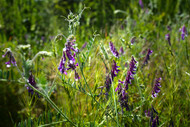Creating a wildflower lawn
Creating a wildflower lawn is a fantastic way to enhance biodiversity, support pollinators, and bring a burst of natural beauty to your garden. Here's a comprehensive guide to help you establish a thriving wildflower lawn.
Planning Your Wildflower Lawn
Assess Your Soil: The first step is to determine your soil type. Wildflowers generally thrive in poor soil conditions, so knowing whether your soil is sandy, clay, or loamy can help you choose the right wildflower mix.
Choose the Right Location: Wildflowers prefer sunny locations. Ensure your chosen spot receives at least six hours of direct sunlight daily.
Select the Right Mix: Different wildflower mixes cater to different soil types and sunlight conditions. Research the varieties that will best suit your garden's specific conditions. Native species are often the best choice as they are adapted to local climates and support local wildlife.
Preparing the Ground
Clear the Area: Remove any existing vegetation. This can be done by digging out plants, using a herbicide, or covering the area with black plastic to kill off weeds.
Prepare the Soil: Since wildflowers thrive in less fertile soil, you might need to remove some topsoil if it's rich or add sand to improve drainage. Avoid using fertilizers as they encourage the growth of grasses and weeds that can outcompete wildflowers.
Rake and Level: Lightly rake the soil to create a fine, even surface. This helps ensure good seed-to-soil contact, which is crucial for germination.
Sowing the Seeds
Best Time to Sow: The optimal time to sow wildflower seeds is in the spring or autumn. Autumn sowing allows seeds to establish before winter, while spring sowing takes advantage of warming temperatures and longer daylight hours.
Sowing the Seeds: Mix the seeds with sand to help distribute them evenly. Sow the seeds by hand, scattering them over the soil surface. Aim for a density where the seeds are evenly spread but not overcrowded.
Press the Seeds In: After sowing, lightly press the seeds into the soil using a roller or by walking over the area. This ensures good contact with the soil, which is essential for germination.
Caring for Your Wildflower Lawn
Watering: Keep the soil moist until the seeds have germinated and the young plants are established. This usually means watering lightly but regularly, especially during dry spells.
Weed Control: In the first year, your wildflower lawn might need some weeding to prevent aggressive weeds from taking over. Hand-pulling weeds is usually sufficient.
Mowing: Once established, wildflower lawns require minimal maintenance. In late summer, after the flowers have set seed, cut the lawn down to about 5-10 cm. This simulates the natural grazing and helps scatter the seeds for the next season.
Long-Term Maintenance
Annual Cutting: An annual cut is essential to prevent grasses and woody plants from dominating. The best time for this is after most of the wildflowers have set seed, usually in late summer or early autumn.
Remove Cuttings: After cutting, remove the clippings to prevent nutrient build-up in the soil, which could encourage grasses over wildflowers.
Overseeding: Every few years, you might need to add more wildflower seeds to maintain diversity and density. Autumn is the best time for overseeding.
Benefits of a Wildflower Lawn
Biodiversity: Wildflower lawns support a wide range of insects, birds, and other wildlife, contributing to a healthier ecosystem.
Aesthetic Appeal: The vibrant, changing palette of colors provides year-round interest and beauty.
Low Maintenance: Once established, wildflower lawns require less frequent mowing and watering compared to traditional lawns.
Troubleshooting Common Problems
Poor Germination: Ensure seeds are pressed into the soil and keep the area moist. If birds are eating the seeds, consider using a light covering of straw.
Dominance of Grasses/Weeds: Regularly remove invasive species by hand, especially in the first year. Avoid using fertilizers that can boost unwanted plant growth.
Sparse Flowering: If your wildflower lawn appears thin, overseed the area in autumn to improve density and diversity.
By following these steps, you can create a beautiful and sustainable wildflower lawn that not only enhances the aesthetic appeal of your garden but also supports local biodiversity. Enjoy the process and the vibrant life that will flourish in your new wildflower habitat.

